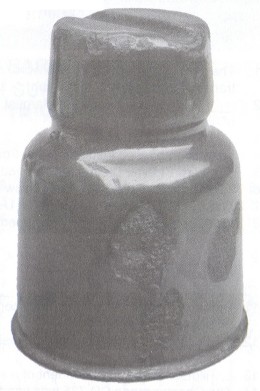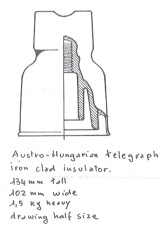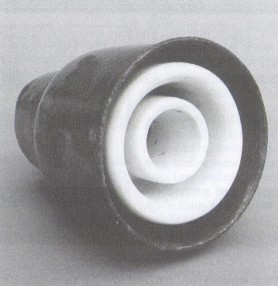Austro-Hungarian Telegraph Iron Clad Insulator
by Guido Boreani
Reprinted from "Crown Jewels of the Wire", January 2000, page 24
I have been an insulator collector since the late 1950's and have only
recently discovered Crown Jewels of the Wire.
It is my desire to share with all my collector friends the unusual and
unknown (maybe to them) insulators in my collection in the hope that it will be
of interest.

I read in the June 1999 issue the article by Marilyn Albers about
the ironclad insulator found in Uruguay. I have something similar that I found
in 1967 in the scrap heap of a telegraph workshop in Udine, in northeastern
Italy. It is a white porcelain insulator covered by a shell of sheet pressed
iron or steel enameled in a dark grey color, which is secured to the porcelain
with cement.

It measures 134 mm high (5-1/4"),102 mm diameter (4") and weighs
1,5 kilograms (about 3Ibs.) The workshop personnel told me that this insulator
is of Austrian origin. Part of the area covered by the Udine workshop was Austro-Hungarian
Empire until 1918, so it is very likely that former Austrian telegraph line
material which remained until recent times in Italian territory. The iron shell
is a bit thin (about 1,5 mm) but has proven to resist shocks, as can be seen by
the many damages suffered by the enamel, well visible in the photos.

And, speaking of iron shells, the insulator featured in the October issue of
Crown Jewels of the Wire (page 6), is certainly an overhead wire insulator but
not for ordinary trolley lines, I think. These two flanges at the top end
suggest bolts fixing to an upper member, such as a bridge or the ceiling of a
tunnel, that makes me think it was designed for mine use where the proximity of
the suspension points would have lessened the shocks caused to the insulator by
the current collector, thus allowing for the use of glass instead of more
elastic composite material generally adopted for trolley wire insulation. The
purpose of the depression on the top is only to spare iron and lighten the
shell.
I realize that I have not spoken of Italian insulators, and this is odd
as a first contact by an Italian collector, but I will correct that next time.
| 